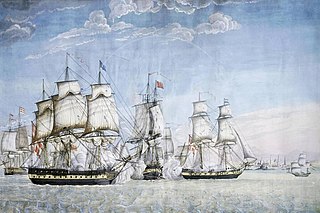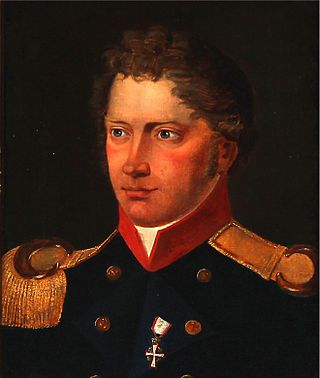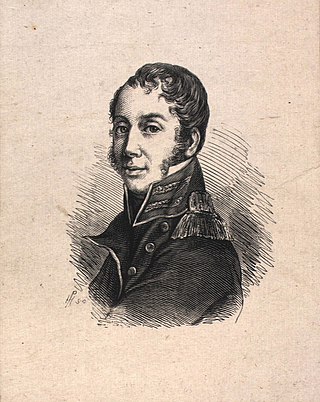
The Action of 16 May 1797 was a naval battle that took place near Tripoli in Ottoman Tripolitania. The Danish squadron was attacked by a Tripolitan squadron that outnumbered them in number of vessels.

HDMS Najaden was a frigate of the Royal Dano-Norwegian Navy, which she served from 1796 until the British captured her in 1807. While in Dano-Norwegian service she participated in an action at Tripoli, North Africa. She served the Royal Navy as the fifth rate HMS Nyaden from 1808 until 1812 when she was broken up. During her brief British service she participated in some small attacks in the Barents Sea during the Anglo-Russian War.

Jens Schou Fabricius was the Norwegian appointed Minister of the Navy 1817–1818. He served as a representative for Søe-Deffensionen at the Norwegian Constitutional Assembly at Eidsvoll in 1814. During his naval career he served first the Danish-Norwegian Crown until the separation in 1814 of Norway and Denmark, and thereafter the Norwegian-Swedish Crown. Fabricius retired from the navy as a vice admiral.

Peter Nicolay Skibsted (1787–1832) was a Danish naval officer with a successful career marred only by the loss in 1810 of a squadron of three gunboats under his command to the British.

Hans Peter Holm was a Danish naval officer who commanded vessels of the Dano-Norwegian Navy in several actions. He commanded several naval vessels during the Gunboat War. His most important action occurred in 1812 at the Battle of Lyngør when a British squadron, led by the British ship-of-the-line HMS Dictator, destroyed his vessel, HDMS Najaden. Holm sustained wounds in the battle but survived, only to drown in an accident shortly afterwards.
The name of Steen Andersen Bille is closely associated with one extended Bille family of Danish naval officers over several generations.

Admiral Steen Andersen Bille was a Danish naval officer. A a member of the Bille family, he rose to the rank of admiral and became a privy counselor during the period of Denmark-Norway's policy of "armed neutrality" following the Gunboat War. He was instrumental in the rebuilding of the Danish Navy after 1814.

HDMS Friderichssteen or HMS Frederichsteen was a Danish Navy frigate, built in 1800, and captured by the Royal Navy in 1807 at the Battle of Copenhagen. She was taken into service as HMS Fredericksteen and served in the Mediterranean until being finally broken up in 1813.
HDMS Friderichsværn was a Danish frigate built at Nyeholm, Copenhagen, in 1783. The British Royal Navy captured her in 1807 and took her into service as HMS Frederickscoarn. It sold her in 1814.
Vice-Admiral Henrik Lorentz Fisker was a Danish naval officer and politician. He was the son of an attorney at the supreme court, and deputy mayor of Copenhagen. From the age of thirteen as a cadet in the Danish-Norwegian navy, he rose through the ranks to vice admiral in 1775 and full admiral in 1790. He died 20 June 1797 and was buried in the Holmens Kirkegård, the Danish naval cemetery, in Copenhagen.

Frantz Christopher Henrik Hohlenberg was a Danish naval officer who specialised in ship design and had little seagoing experience. He succeeded Ernst Wilhelm Stibolt as Master Shipbuilder (fabriksmester) at the Royal Danish Dockyards in 1796. His ships included five ships of the line and 18 frigates. Three of the ships of the line and nine of the frigates were captured at the 1807 Battle of Copenhagen and subsequently added to the Royal Navy. He resigned after a controversy in 1803.
HDMS Hvide Ørn , was a light frigate designed by Frantz Hohlenberg and built in Copenhagen. She capsized and was lost with all hands off Corsica at the end of 1799. There were three previous ships bearing this name in the Danish navy. The name was after the loss of the ship retired. An 1898 model of the ship is in the collection of the Royal Danish Naval Museum.
HDMS Ørnen (1694) was a frigate in the Royal Danish Navy active during the Great Northern War

Michael Bille (1680–1756) was an officer in the Danish Royal Navy during the Great Northern War. He was commissioned as a junior lieutenant in 1699, advancing steadily to become Vice Admiral when he retired in 1737.

Daniel Ernst Bille was a naval officer and rear admiral in the service of the Danish crown.
Bendix Lasson Bille was a naval officer and rear admiral in the service of the Danish crown.
HDMS Nidelven was a brig launched at Copenhagen on 1 December 1792. She was present at both British attacks on Copenhagen, and the British Royal Navy seized her at Copenhagen on 7 September 1807 at the surrender of Copenhagen. The British took her into service as HMS Nid Elven. She served between 1808 and 1809, during which time she captured a small French privateer. She was laid up in 1809. The Navy sold her in 1814.
De Fire Søstre was the name of five separate ships which served purely as merchant ships or, for part of their lives, hospital and supply ships to the Danish fleet.

HDMS Justitia was a 72-gun ship of the line of the Royal Dano-Norwegian Navy built to a design by Henrik Gerner. Although launched in 1777, she was not fully commissioned until 1780. The Royal Navy captured her together with most of the Dano-Norwegian navy after the battle of Copenhagen in 1807. The British never commissioned Justitia. A renaming to Orford in 1809 was cancelled. She was broken up in 1817.

HDMS Justitia was a ship-of-the-line designed by Ole Judichaer built at Nyholm, Copenhagen for the Royal Danish-Norwegian Navy.














